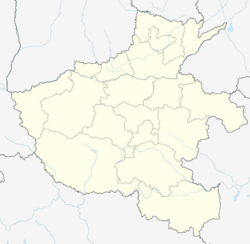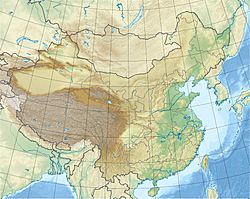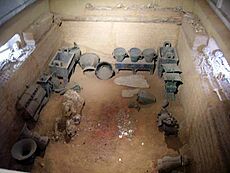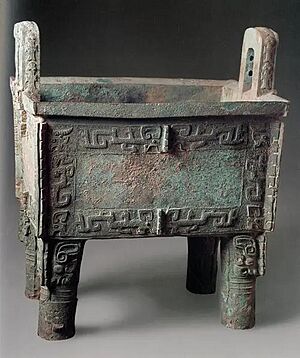Yinxu facts for kids
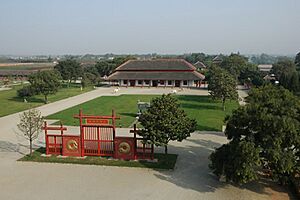
Yinxu, the site of the Shang dynasty capital between c. 1350 and c. 1046 BCE
|
|
| Location | Yindu District, Anyang, Henan, China |
|---|---|
| Coordinates | 36°7′21″N 114°19′7″E / 36.12250°N 114.31861°E |
| UNESCO World Heritage Site | |
| Official name | Yin Xu |
| Criteria | Cultural: ii, iii, iv, vi |
| Inscription | 2006 (30th Session) |
| Area | 414 ha |
| Buffer zone | 720 ha |
| Yinxu | |||||||||||||||||||||
|---|---|---|---|---|---|---|---|---|---|---|---|---|---|---|---|---|---|---|---|---|---|
| Chinese | 殷墟 | ||||||||||||||||||||
| Literal meaning | "Ruins of Yin" | ||||||||||||||||||||
|
|||||||||||||||||||||
Yinxu is an ancient archeological site in China. It was once the final capital city of the Shang dynasty, a powerful kingdom that ruled China a very long time ago. The name Yinxu means "Ruins of Yin."
This important site is located in Anyang, in the Henan province of China. It was the capital city during the Late Shang period, from about 1250 to 1046 BCE. During this time, 12 Shang kings ruled from Yinxu. It was also where oracle bone script, the earliest known Chinese writing, first appeared.
For thousands of years, Yinxu was forgotten. But in 1899, it was rediscovered when people found strange bones being sold nearby. These bones had ancient writing on them. This discovery led to many years of digging and studying the site. Yinxu is now one of China's oldest and largest archaeological sites. In 2006, UNESCO named it a World Heritage Site. You can visit Yinxu today to learn about this amazing ancient city.
Contents
The Story of Yinxu
According to old Chinese stories, the name Yin (殷) originally meant "vibrant music-making." The name Yin was used by the later Zhou dynasty to talk about the Shang dynasty and its last capital. However, the Shang people themselves called their state Shāng (商). They called their capital Dàyì Shāng (大邑商), which means "Great Settlement Shang."
How Yinxu Became the Capital
Ancient Chinese books tell us that Yin was the last capital of the Shang dynasty. There are different ideas about exactly when the capital moved there. Some old texts, like the Book of Documents and the Bamboo Annals, say that King Pan Geng moved the Shang capital to Yin. The Bamboo Annals even say he moved it from a place called Yan to a site named Beimeng, which was then renamed Yin.
No matter the exact date, Yinxu was definitely the Shang capital by the time King Wu Ding ruled. King Wu Ding was a very strong leader. He led many military campaigns from Yinxu against nearby tribes. This helped the Shang dynasty become very powerful and reach its peak.
The End of the Shang Dynasty
Later Shang kings, however, became less interested in ruling. They preferred to have fun instead of taking care of their kingdom. King Zhòu, the very last Shang king, is remembered for being cruel and enjoying too much luxury. His harsh rules made the nobles unhappy.
Because of this, King Wu of the Zhou dynasty was able to get enough support to rise up. He overthrew the Shang dynasty. After the Zhou dynasty took over, they built their own capital far away. Yinxu was left empty and slowly turned into ruins.
These ruins were mentioned in old writings, but for a long time, Yinxu was just a legend. It wasn't until the late 1800s that it was rediscovered.
Amazing Discoveries at Yinxu

Yinxu is famous for its oracle bones. These bones were first recognized as ancient Chinese writing in 1899 by a scholar named Wang Yirong. One story says that Wang Yirong was sick and bought some "dragon bones" from a traditional Chinese pharmacy. He noticed strange carvings on them and realized they were ancient writing.
News of these oracle bones spread quickly. People started digging illegally to find them, and tens of thousands of pieces were taken. Eventually, people traced the bones back to a small village near Anyang called Xiaotun. In 1910, scholars confirmed that this area was indeed the site of the last Shang dynasty capital.
In 1917, another scholar, Wang Guowei, figured out the names of the Shang kings from the oracle bone writings. He created a complete family tree of the Shang kings. This matched what was written in an old book called the Records of the Grand Historian. This proved that the Shang dynasty was real and that Yinxu was a very important historical site.
Official Excavations Begin
The first official archaeological digs at Yinxu happened from 1928 to 1937. These digs were led by archaeologist Li Ji. They found the remains of a royal palace and several royal tombs. They also uncovered more than 100,000 oracle bones. These bones showed that the Shang people had a very organized writing system.
Since 1950, archaeologists have continued to dig at Yinxu. They have found evidence of palaces, temples, and royal cemeteries. They also found workshops where people made bronze and bone items. These discoveries have helped us understand a lot about the Shang dynasty. Yinxu is one of the most important sites for Chinese archaeology.
Exploring the Excavation Sites
Yinxu is a huge archaeological site, covering about 30 square kilometers. That's like 3,000 football fields! Digs have uncovered over 80 places where buildings once stood, including palaces, temples, tombs, and workshops. These findings confirm that Yinxu was the main spiritual and cultural center of the Shang dynasty.
One of the most amazing discoveries at Yinxu is the Tomb of Fu Hao. Lady Hao was a powerful military leader and one of the wives of Shang King Wu Ding. Her tomb was found in 1976. It was special because it had not been robbed, unlike other tombs at the site.
Inside Lady Hao's tomb, archaeologists found her remains, along with the skeletons of six dogs and 16 human servants. They also found many valuable items, like bronze weapons, jade carvings, and pottery. The tomb has been carefully restored and is now open to visitors. You can also see chariot pits nearby, which show the earliest animal-driven carts found in China.
Why Yinxu is Important to History
Before Yinxu was excavated, many people weren't sure if the Shang dynasty was real. The oldest clear historical records in China started with the Zhou dynasty, which came after the Shang. But the discovery of the oracle bone inscriptions at Yinxu proved that the Shang dynasty truly existed. This helped historians understand early Chinese history much better.
The 150,000 oracle bones found at Yinxu are some of the earliest examples of written Chinese. They tell us a lot about the Shang people's lives, their beliefs, and their kings. The bronze and jade items found at Yinxu also show us how the Shang people buried their dead, sometimes with human and animal sacrifices.
Archaeologists have also found many workshops at Yinxu. These workshops produced beautiful handicrafts. The patterns on their bronze and pottery items often show animal faces or swirling designs. Very large bronze items, like the Houmuwu ding, were made using a complex process. This shows how skilled the Shang artisans were.
Images for kids


